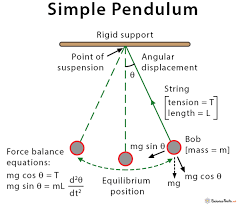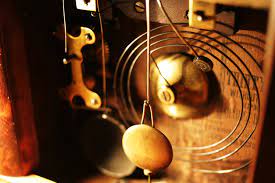“Mastering Damped Oscillations: Delving The Physics of Vibrations and Damping Forces”
Damped oscillation is like the slowing down of a bouncing ball. Imagine you push a ball downwards, and it starts bouncing up and down. Now, picture that with each bounce, it doesn’t go as high as the previous one. That’s damped oscillation – the ball’s bouncing, but it’s losing energy, and eventually, it stops bouncing altogether.


2. Damped oscillation occurs when a system, like a spring or a pendulum, gradually loses energy over time.


– The damping force, usually caused by friction or air resistance, acts against the motion of the system.
– As a result, the amplitude of the oscillations decreases with each cycle until it eventually comes to a stop.
3. Think of it like swinging on a swing. Initially, you swing back and forth with a certain amplitude, but over time, the air resistance slows you down until you stop swinging. This is because of things like air resistance and friction, which act to slow things down. We can often ignore or make these forces small in some situations, but finding something that moves without slowing down at all is pretty rare.

In the real world, things that move back and forth, like a swinging pendulum or a vibrating guitar string, usually don’t keep going forever. They slow down and stop because of things like friction.
. For example, when you pluck a guitar string, it doesn’t keep vibrating for a long time; it stops after a few seconds.
Even when you’re on a playground swing, you need to keep giving it a push to keep going.
In certain cases, we might actually want to slow down or dampen these back-and-forth motions. Car shock absorbers are a good example – they help make the car ride smoother by reducing the bounciness of the suspension. So, in real life, it’s more common for things to have some kind of damping or slowing down in their oscillations.



Explanation: Think about a car with really good shock absorbers. When you go over a bump, the car doesn’t keep bouncing up and down endlessly. The shocks absorb the energy, making the car settle smoothly. That process of settling down is a kind of damped oscillation.
In physics, we often encounter damped oscillation when there’s a force slowing things down. It’s like stirring honey with a spoon – the honey resists the motion and gradually comes to rest.

Examples:
- Swinging Pendulum in Honey-Like Fluid: If you imagine a pendulum swinging in a thick fluid like honey, the resistance from the fluid would gradually bring the pendulum to a stop. This slowing down is damped oscillation.
- Closing a Door with a Damper: When you close a door gently, some doors have dampers that prevent them from slamming shut. The controlled, smooth closing of the door is a result of damped oscillation.
. Applications: - Car Ride Comfort: Next time you’re in a car, think about the smooth ride, especially when going over bumps. The car’s suspension system uses damped oscillation to absorb the shock, ensuring you don’t feel every bump on the road.
- Building Stability During an Earthquake: Engineers use damped oscillation principles in designing buildings to absorb and dissipate energy during earthquakes. This helps prevent excessive swaying and ensures the structure stays stable.
- Understanding damped oscillation is crucial in creating systems and structures that don’t just move but do so in a controlled and stable way, making everything from car rides to building designs safer and more comfortable.
FAQ: Damped Oscillation
1. What is damped oscillation?
A. Damped oscillation refers to the gradual decrease in amplitude of an oscillating system over time due to the presence of damping forces, such as friction or air resistance.
2. How does damping affect oscillation?
- Damping influences oscillation by dissipating energy, causing the amplitude of the oscillations to decrease over time. It’s a crucial aspect in understanding the behavior of systems like springs and pendulums.
3. What are the types of damping?
A. There are three main types of damping: viscous or linear damping, Coulomb or dry friction damping, and structural or hysteretic damping.
4. How is the damping ratio related to damped oscillation?
- The damping ratio is a dimensionless quantity that describes the rate at which a system loses its oscillatory energy. It is a key parameter in understanding the behavior of damped oscillation.
5. Can you provide examples of damped oscillation in real life?
A. Examples include a swinging door gradually coming to rest, a car’s suspension system responding to bumps, or the motion of a boat on the water.
6. How does damping affect the resonance of a system?
A. Damping reduces the amplitude of oscillations and widens the resonance peak. Excessive damping can suppress resonance, while insufficient damping can lead to overshooting.
7. What is critical damping, and why is it important?
A. Critical damping occurs when a system returns to equilibrium as quickly as possible without oscillating. It is crucial in engineering to prevent overshooting and oscillations.
8. How can damped oscillation be applied in engineering and technology?
A. Damped oscillation principles are applied in designing shock absorbers, car suspensions, building structures to withstand earthquakes, and various mechanical systems to control vibrations.
9. How can I analyze damped oscillation in a system?
A. Analyzing damped oscillation involves understanding the damping ratio, natural frequency, and initial conditions. Differential equations and numerical methods are commonly used for analysis.
10. What factors influence the damping in a system?
A. Factors include material properties, external forces, temperature, and the presence of lubricants, all of which contribute to the overall damping effect.

2 comments